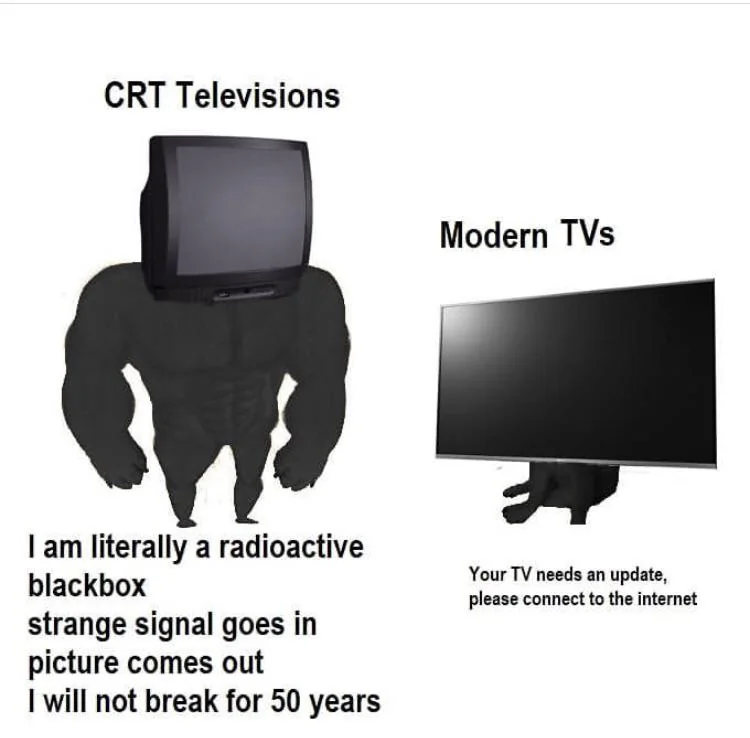this post was submitted on 27 Nov 2023
829 points (95.4% liked)
Memes
9129 readers
353 users here now
Post memes here.
A meme is an idea, behavior, or style that spreads by means of imitation from person to person within a culture and often carries symbolic meaning representing a particular phenomenon or theme.
An Internet meme or meme, is a cultural item that is spread via the Internet, often through social media platforms. The name is by the concept of memes proposed by Richard Dawkins in 1972. Internet memes can take various forms, such as images, videos, GIFs, and various other viral sensations.
- Wait at least 2 months before reposting
- No explicitly political content (about political figures, political events, elections and so on), [email protected] can be better place for that
- Use NSFW marking accordingly
Laittakaa meemejä tänne.
- Odota ainakin 2 kuukautta ennen meemin postaamista uudelleen
- Ei selkeän poliittista sisältöä (poliitikoista, poliittisista tapahtumista, vaaleista jne) parempi paikka esim. [email protected]
- Merkitse K18-sisältö tarpeen mukaan
founded 2 years ago
MODERATORS
you are viewing a single comment's thread
view the rest of the comments
view the rest of the comments


CRTs don't have pixels so the resolution of the signal isn't that important. It's about the inherent softness you get from the technology. It's better than any anti-aliasing we have today.
CRTs do have pixels. If they didn't, you could run an SVGA signal (800x600 at 60 Hz) directly into any CRT. If you tried this, it would likely damage the tube beyond repair.
The exact mechanism varied between manufacturers and types: http://filthypants.blogspot.com/2020/02/crt-shader-masks.html
I certainly saw aliasing problems on CRTs, though usually on computer monitors that had higher resolution and better connection standards. The image being inherently "soft" is related to limited resolution and shitty connections. SCART with RGB connections will bring out all the jagginess. The exact same display running on composite will soften it and make it go away, but at the cost of a lot of other things looking like shit.
Would it, though? I'm skeptical.
If it did, it wouldn't be because they have "pixels," though; it would be because overdriving the deflection yoke with higher-frequency signals would generate too much heat for the TV to handle.
Otherwise (if it didn't overheat), it should "work." The result might look weird if the modulation of the signal didn't line up with the apertures in the shadow mask right, but I don't see any reason why sweeping the beam across faster would damage the phosphors. (Also, I'm not convinced a black & white TV would have any problem at all.)
It will tend to turn the beam on when it's off to the side, outside the normal range of the screen. X Windows users in the mid 90s had to put in their exact scanline information or else the screen could blow up. That went away with a combination of multiscan monitors and monitors being able to communicate their preferred settings, but those came pretty late in the CRT era.
Edit: in any case, color screens need to have at least bands of red/green/blue phosphor. At a minimum, there will be breaks along either the horizontal or vertical lines, if not both.
When you say "blow up" do you mean the tube would literally explode, it would burn through phosphors, a circuit board would let the magic smoke out, or something else?
I remember configuring mode lines in X. Luckily, I never found out the hard way what happened if you got it wrong.
Literally blow up the tube in the worst cases.
Interesting, TIL!
I remember doing that configuration for X.
You had to tell it when to change lines, when to start firing on a new line (i.e. you changed lines then waited a bit and only after started sending data), then when to stop firing and finally another wait after which a change lines (so there was some "empty" at the start and at the end of a horizontal electron gun trace and you had to tune those so that the image didn't start or end outside the screen).
There was also something similar for the vertical axis - i.e. instructing it to go back to the top and some empty lines at the top and the bottom.
I wouldn't say it was convenient (it was a bloody text file with weird-looking numbers and you did run the risk of blowing up the CRT), but it was kinda fun that you could create your own crazy screen resolutions for X once you understood the principle of the thing.
Crts were jagged and blurry. A misconverged pixel isn't good anti aliasing.
https://en.m.wikipedia.org/wiki/Missile_Command#/media/File%3AA5200_Missile_Command.png
That image is a digital rendering of the raw data, not a photo of how a CRT would render it.
CRTs were nothing if not the opposite of jagged.
I grew up on 2600 on a tv in the 70's. Computer graphics on crts were incredibly jagged. If you used a magnifying glass on a pixel it was blurred misconverged spot because it didn't hit the shadow mask exactly on target.
Look at that rope: https://www.deviantart.com/gameuniverso/art/Review-of-Pitfall-Atari-5200-761326088
"Blurred" is the opposite of "jagged," though.
The jaggedness of the 2600 wasn't because the TV itself was jagged; it was because the 2600 was so low-resolution (160x192, maximum) that it had to be upscaled -- naively, with no antialiasing! -- even just to get to NTSC (480 scanlines, give or take).
So yeah, when each "pixel" is three scanlines tall, of course it's going to look jagged even after the CRT blurs it!
A high resolution LCD with anti aliasing will do a better job than a low resolution crt. Crt shadowmasks defined the limits of pixels and it wasn't good even on computers that could output higher than 2600 resolution.